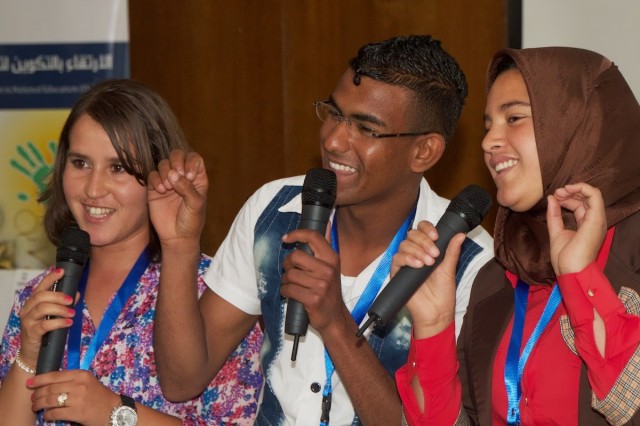
Eric Rusten
Students who drop out don’t just disappear. They often become under-employed, more likely to have shorter life spans and fail to become active members of civic activities.
In Morocco, the numbers are staggering: 300,000 to 400,000 children drop out of school yearly. The rate for 7th, 8th or 9th graders in 2010 reached 10.8 percent, according to the Education Ministry. While government efforts have lowered the rate of dropouts, today, a first grader has a 50-50 chance of completing high school, UNICEF reports.
While the Moroccan government, donors and others are working to address this persistent problem, those who are directly affected are rarely consulted about the reasons they drop out of school or asked to offer ideas about what could be done to reduce the number of dropouts. The few times when youth are consulted, the process is controlled by adults.
Engaging Middle School Students
Youth Speak – Morocco addresses this gap by enabling middle school youth who are personally involved in the drop out problem to lead and conduct research with their peers and other stakeholders to ensure that youth perspectives are collected and clearly presented.
In short, Youth Speak is research carried out by youth, with youth and for youth.
This youth-led research and awareness-raising initiative enabled 12 youth in middle school and 12 youth who had dropped out of middle school to conduct rigorous research on factors that contribute to youth dropping out of school with other middle school-age youth and members of local communities.
Youth Speak – Morocco, which contributed to the Moroccan Government’s efforts to reduce drop outs, was implemented through USAID’s Improving Training for Quality Advancement in National Education (ITQANE) project, administered by Creative Associates International. The project was also implemented in partnership with the Education Ministry’s Directorate of Non Formal Education.
Youth Speak – Morocco sought to better understand of the factors that contribute to youth dropping out of school, as well as the actions that schools, communities, families and the government can take to reduce the rates. It also addresses the challenges youth face in transitioning from school to work.
Youth Speak – Morocco raises awareness of the drop out issue and creates more effective relationships among local stakeholders to rapidly reduce the number of youth dropping out of school.
Relevant Research
The 24 youth, organized in teams of four, conducted the research in six communities around Morocco. Three research methods—a survey, several focus group discussions and in-depth interviews—were used to gather information from middle school students, youth who had recently dropped out, parents and community representatives.
The research teams, adult coaches two Youth Speak coordinators and Creative staff then analyzed the data. Each team prepared local research reports that were reviewed by Education Ministry officials.
The teams then organized local events to present their results to youth, teachers, officials and parents from their schools and communities. Following these local events, the six teams were brought together for a national event in Fez.
The youth-led research produced the following findings:
- Complex and rigid curricula not adapted to 21st century youth led to poor performance
- Long distance from home to school and limited access to transportation
- Insufficient safety on the road to school
- Violence and a lack of security in the school vicinity
- 43 percent of interviewed dropouts state that they left school to earn a living to support their families
Despite these problems, those surveyed see the value of education.
Click here for photo slideshows from day one to final day of the Youth Speak event!
Eric Rusten is a Senior Associate, Education for Development Division, Creative Associates International.